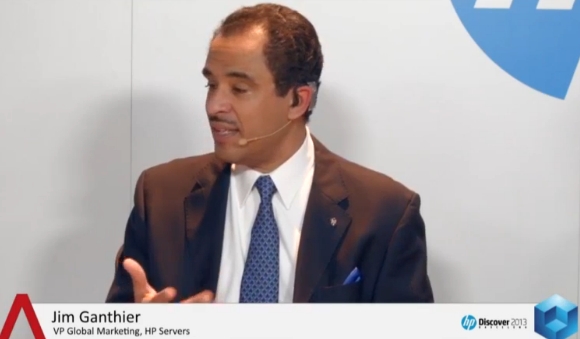 NEWS
NEWS
 NEWS
NEWS
 NEWS
NEWS
![]() Stationed in Barcelona for three days full of tech talk and geekery, John Furrier and Dave Vellante, theCUBE co-hosts, happily welcomed Jim Ganthier, VP of Global Marketing for HP Servers, getting him talking about HP industry standard products as well as about HP’s services and solutions.
Stationed in Barcelona for three days full of tech talk and geekery, John Furrier and Dave Vellante, theCUBE co-hosts, happily welcomed Jim Ganthier, VP of Global Marketing for HP Servers, getting him talking about HP industry standard products as well as about HP’s services and solutions.
Furrier began by asking for an update on what’s going on in the HP world right now regarding servers, big business, facts, figures, market share and data.
“There are a couple of things going on with us,” started Ganthier. “When it comes to HP Servers, our mission in life is really simple: deliver the right compute for the right workload at the right economics every single time. ”
theCUBE hosts prodded Ganthier to elaborate and explain “Why is everyone so in love with Moonshot?”
“Everybody normally does the next turn of the server; every 14-18 months they add more memory, more I/O, they’ll issue the next silver box. Instead of offering a general purpose server, we decided to focus on a software-defined server. Instead of starting with the hardware and adding the software on top, we wanted to understand the software and the workload, and then design the perfect amount of compute, spindles, memory, I/O for it. When you do that, you get a dramatically different set of business results. HP Moonshot equals 89 percent less energy. One rack of moonshot equals eight, nine racks of standard servers. That means less footprint, less admin time, less updates,” explained Ganthier.
In other words, the HP Moonshot system was designed to addresses the speed, scale and specialization required by IT in order to keep up with the converging trends on social media, Big Data, cloud and mobility. With an increasing demand for digital content delivered on (mobile) devices and the Internet of Things calling for specialized solutions, there was a growing need for a new style of computing with optimal performance and efficient scaling.
HP’s Moonshot system represents “the world’s first software-defined server platform” that delivers scale and efficiency by employing the right amount of memory, storage and compute to get the job done. This approach saves costs and energy and enables extreme scale-out without an increased management overhead.
Furrier stated that in the beginning Moonshot gave the impression that it was a product which was going to enable cannibalization of HP’s own server business, and asked Ganthier to comment.
“I don’t see any danger,” stated Ganthier confidently. “We invented the x86 market back in the 1989. We were the first ones to do rack-based servers. It is the role of an industry leader to advance to the next level. Instead of us being afraid of the Moonshot, we are actually embracing it.”
“With a huge portfolio, it happens to have a certain business overlap,” said Vellante, inviting Ganthier to address the issue of segmentation.
“It is a quasi-complex problem, as we have a very clear point of view on how we’re going to address that,” he replied. “We have multiple product families: rack, tower, blades, density optimize, Moonshot and, on top of that, multiple market segments. We look at product class, type of customer, market segment and then we design a particular product based on those workloads.”
“One of the sub-level disruption on the market is the flash,” noted Vellante. “Flash is coming back into the server. What kind of opportunity does that create, both from the standpoint of supporting customers and affecting the market?”
“With flash, customers can get dramatic improvements in performance for a small amount of incremental price. If I’m a financial services customer, milliseconds equal millions. Of course I’m willing to pay for that kind of class. By actually having the memory closer to the processor and closer to the actual I/O complex, flash enables to do things much faster. Analyzing the storage area, you can see that not only flash is moving back into the servers, but the servers are moving into the flash-flash storage,” explained Ganthier.
He was then asked by Furrier to explain and differentiate between HP and the industry’s standards.
“Commodity servers give you commodity results. We like to innovate on top of industry’s standards. There are several things that separate us from the pack: we have the world’s biggest supply chain. We can take that size, scale and speed and innovate on top of it on behalf of our customers. Admins spend far too much time doing maintenance and upgrades instead of focusing on innovation and driving better business results,” observed Ganthier. He believes that customers are not looking for everybody else’s answer, but for a solution that will give them that much more incremental improvement. Small details matter because at a certain size and scale, even the smallest number you can save turns into multimillion dollars worth of savings.
The secret of HP’s success on the market is the power of HP as a whole. “We’re number one globally, regarding X86, and we are the only team on the planet that can offer a converged cloud,” boasted Ganthier.
Asked to put a bumper sticker on this event, Jim showed no false modesty: “HP is back with the vengeance, out to help customers in ways other companies can’t.”
Watch the full interview here.
THANK YOU